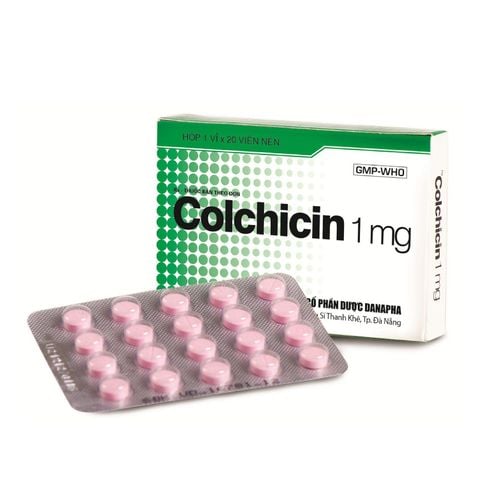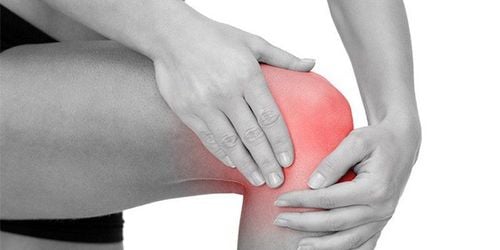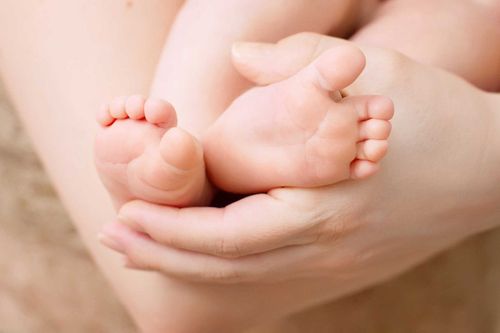This is an automatically translated article.
Children with congenital hip dislocation can walk normally if recognized and intervened early. Hip dislocation in newborns with timely rehabilitation will avoid surgery, the success rate of hip dislocation surgery is usually not high, only about 60%.1. What is an infant hip dislocation?
Congenital hip dislocation in infants is a condition in which the femoral head on one or both sides of the child's hip is dislocated from the normal position of the hip joint. Normally, the femoral head of an infant must be in the socket. A hip dislocation is defined as when the femoral head is not in the joint.The incidence of hip dislocation in newborns is about 1-2/1000, that is, for every 1,000 live births, there are about 1–2 children with congenital hip dislocation. Hip dislocation in children occurs more often in boys than in girls (2 times more).
2. How does hip dislocation in infants affect?
When a child has a hip dislocation, he or she may experience some of the following conditions:Hip dislocation in infants affects movement: when children learn to walk, they are often misaligned, their gait is very bad. Children with hip dislocation will affect psychologically: when hip dislocation is not carried out early rehabilitation, children often have feelings of inferiority, shame, do not dare to participate in fun and learning activities. Exercise and sports at an early age can even affect finding a job and building a family later on. In fact, adults with irreversible hip dislocation often find it difficult to find work because of significantly limited form and function, making it difficult to be accepted by employers. Socially: Children with hip dislocation and adults are often ridiculed by friends and those around them.
3. Causes of hip dislocation in babies
Some causes of hip dislocation can be mentioned as:Newborn hip dislocation due to chromosomal mutations: Children with congenital multi-joint stiffness (hands, clubfoot, knee stiffness) , elbow stiffness, shoulder stiffness, hip dislocation...) The mother has an infection during pregnancy Abnormal fetal position in the womb Unexplained hip dislocation in the newborn.
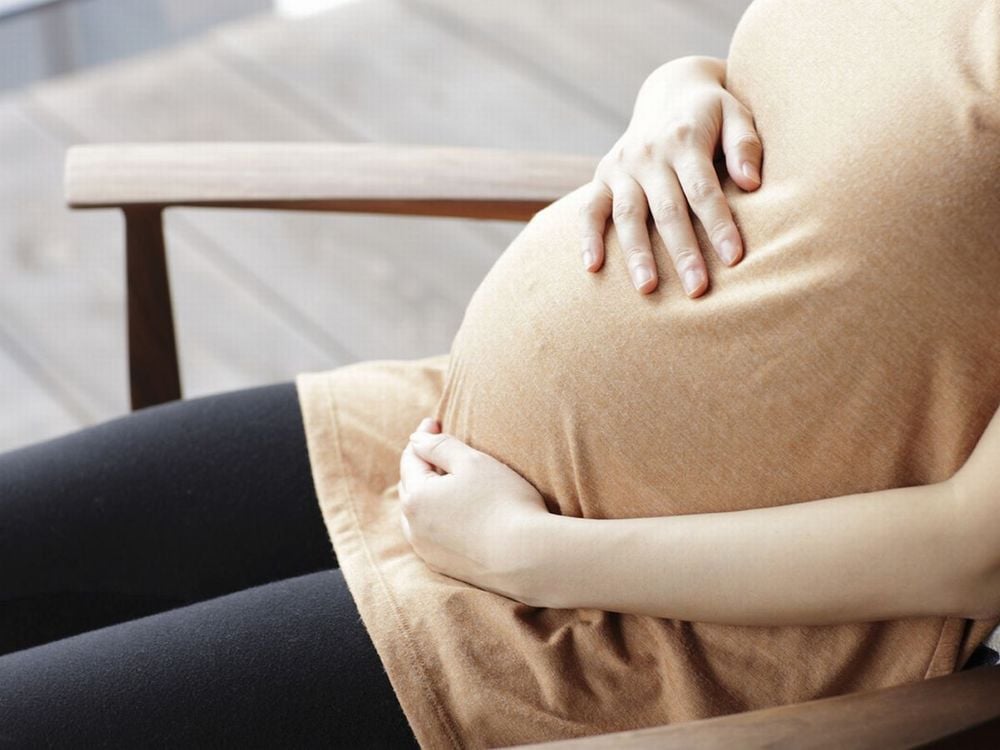
Mẹ bị nhiễm trùng khi mang thai là một trong những nguyên nhân gây trật khớp háng ở trẻ
3. Early detection of signs and symptoms of hip dislocation
A baby with a hip dislocation can be detected soon after birth or a few weeks after birth. There are 8 early signs of baby hip dislocation right after birth:Children have a difference in length of 2 legs: the leg on the side with hip dislocation is usually shorter than the opposite side, but this condition will be difficult to detect when dislocated hip joints on both sides. Wrinkles in the buttocks, thighs, and hamstrings of the hip dislocation side are higher than the normal ones. Children's feet fall out when lying flat. When the child is in the knee flexion position, the knee joint of the dislocated side will be higher. Children with limited hip flexion and flexion. The child's gait when walking will be limp if the hip dislocation is bilateral. Performing Barlow's test: flexing and adduction of the hip will see the femoral head slide out of the joint socket, creating a "click" sound (common in children under 6 months of age); Performing the Ortolani maneuver: flexing and extending the hip will see the femoral head slide out of the joint, creating a "cluck" sound (in infants under 6 months of age) - the opposite of the Barlow Test above. Identification tests: Straight hip arthroplasty, hip ultrasound help diagnose hip dislocation.
4. Rehabilitation of hip dislocation in infants
4.1. Rehabilitation and treatment of hip dislocation Principle:Intervention as soon as possible: Right after birth. Comprehensive intervention: cast, perform mobility exercises, orthopedic braces. Objectives:
Adjust the femoral head back to the correct position in the socket and maintain the femoral head in that position for a minimum of 12 weeks Correction of anterior rotation of the neck and femoral shaft Increase range of motion (flexion and flexion) of the hip Improve the child's gait later. Technique:
Wearing orthopedic brace: The child's hip brace is made of soft foam to help treat hip dislocation on one side or dislocation on both sides. Children with hip dislocation start wearing a brace from right after birth until they are 12 months old, wear it continuously day and night for the first 6 months and may only need to wear a brace at night for the next 6 months. Orthopedic cast: usually indicated for children with congenital hip dislocation before 6 months of age. Orthopedic cast is performed every 2 weeks, about 10-15 times. Note that parents need to monitor their baby after the orthopedic cast at home: If the child's toes show signs of swelling, cyanosis or pain, it is necessary to quickly remove the cast immediately to avoid necrosis. The powder needs to be thoroughly washed for the child, rubbing alcohol on the scratched, ulcerated area. Occupational therapy: perform hip flexion, intra-groin rotation or groin flexion. Orthopedic surgery: can be performed early if conservative treatments do not help improve the child's gait later on. Another measure: keep the baby in a hip and knee flexed position by wearing a diaper, carrying or slinging the baby or placing the baby on his or her stomach while sleeping. Routine examination and follow-up every 3 months for rehabilitation and orthopedic surgeons to assess the child's progress. Have tests like X-rays and ultrasound of the hip to check every 6 months for the first 2 years of life.
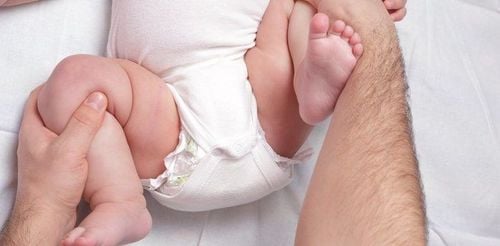
Trẻ bị trật khớp háng bẩm sinh nên được can thiệp càng sớm càng tốt
As a key area of Vinmec International General Hospital, Pediatrics Department always brings satisfaction to customers and is highly appreciated by industry experts with:
Gathering a team of leading pediatric doctors and nurses Faculty: consists of leading experts, with high professional qualifications (professors, associate professors, doctorates, masters), experienced, worked at major hospitals such as Bach Mai, 108.. All doctors are well-trained, professional, have a mind - range, and are knowledgeable about young psychology. In addition to domestic pediatric specialists, the Department of Pediatrics also has the participation of foreign experts (Japan, Singapore, Australia, USA) who are always pioneers in applying the latest and most effective treatment regimens. . Comprehensive services: In the field of Pediatrics, Vinmec provides a series of continuous medical examination and treatment services from Newborn to Pediatric and Vaccine,... according to international standards to help parents take care of their baby's health from birth to childhood. from birth to adulthood Specialized techniques: Vinmec has successfully deployed many specialized techniques to make the treatment of difficult diseases in Pediatrics more effective: neurosurgery - skull surgery, stem cell transplantation. blood in cancer treatment. Professional care: In addition to understanding children's psychology, Vinmec also pays special attention to the children's play space, helping them to have fun and get used to the hospital's environment, cooperate in treatment, improve the efficiency of medical treatment.
Please dial HOTLINE for more information or register for an appointment HERE. Download MyVinmec app to make appointments faster and to manage your bookings easily.





